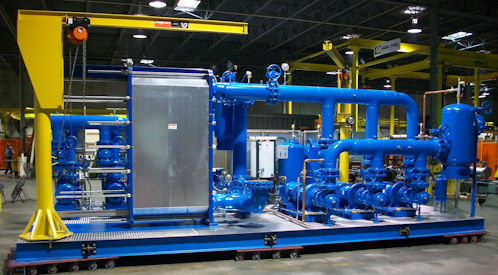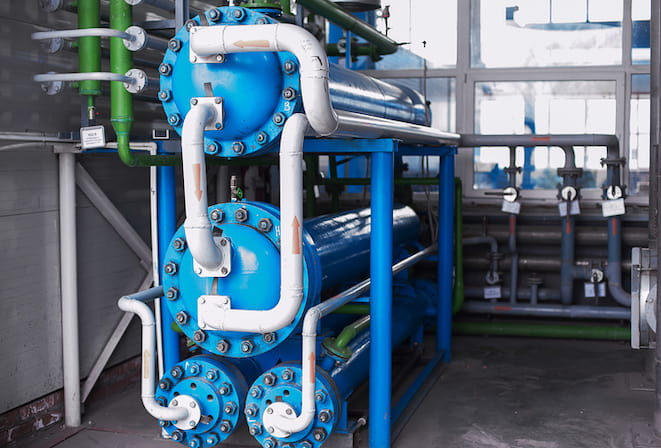Why Choose DVS Heat Transfer Systems for Compact Heat Exchanger Designs
Innovations in Heat Transfer Solutions: What You Required to Know for Ideal Efficiency
Innovations in Heat transfer systems are transforming efficiency throughout numerous sectors. Advanced products like graphene and nanofluids promise substantial renovations in thermal conductivity. The assimilation of IoT and machine understanding offers opportunities for real-time tracking and improved power efficiency. Nevertheless, the landscape of thermal monitoring is swiftly advancing (DVS Heat Transfer Systems). Understanding these developments is important for accomplishing ideal system performance and sustainability in the future. What details improvements are forming this transformation?
Emerging Products for Boosted Heat Transfer

Advanced Heat Exchanger Layouts
While traditional Heat exchangers have actually served their objective in numerous applications, progressed layouts are now arising to satisfy the boosting needs for effectiveness and efficiency. These ingenious styles, such as plate, shell-and-tube, and finned-tube Heat exchangers, include improved area and improved flow patterns to increase thermal transfer rates. On top of that, small designs allow for reduced room needs without jeopardizing performance. Advanced products, such as composites and corrosion-resistant alloys, additionally boost toughness and efficiency under extreme problems. Moreover, simulation modern technologies and computational liquid characteristics are increasingly used to fine-tune these layouts, guaranteeing peak Heat transfer qualities. As sectors look for to lessen energy consumption and take full advantage of result, the fostering of innovative Heat exchanger layouts is essential in achieving these objectives.
The Duty of Nanotechnology in Heat Transfer
Nanotechnology plays an important duty in improving thermal conductivity within Heat transfer systems. By controling products at the nanoscale, scientists have attained significant enhancements in energy performance. These innovations not only enhance performance yet also add to even more lasting power services.
Improved Thermal Conductivity
Considerable improvements in thermal conductivity have arised with the application of nanotechnology, changing Heat transfer systems throughout various sectors. By incorporating nanoparticles into Heat transfer liquids and products, scientists have accomplished impressive rises in thermal conductivity. These nanoparticles, such as carbon nanotubes, graphene, and steel oxides, boost the Heat transfer residential properties due to their high area and special thermal qualities. The resulting composites show boosted performance in applications ranging from electronics cooling systems to eco-friendly power modern technologies. The capacity to customize the dimension, shape, and composition of nanoparticles permits for optimized thermal administration options. Therefore, nanotechnology remains to play a pivotal duty in the development of more reliable and efficient Heat transfer systems, leading the method for enhanced commercial applications.
Energy Efficiency Improvements

Integration of IoT in Heat Transfer Equipments
The integration of IoT in Heat transfer systems introduces the execution of wise sensing units that enhance operational efficiency. These sensors allow real-time information tracking, permitting instant modifications and optimizations. This technological innovation has the prospective to considerably improve efficiency and power monitoring in Heat transfer applications.
Smart Sensors Execution
As Heat transfer systems evolve, the combination of clever sensors through the Net of Things (IoT) has arised as a transformative strategy. These sensing units allow real-time monitoring of circulation, pressure, and temperature level rates, improving system effectiveness and integrity. By gathering and transmitting information, they help with proactive maintenance, decreasing the risk of system failings. Furthermore, clever sensing units add to power cost savings by refining functional criteria based upon ecological conditions. Their capability to examine trends and anomalies enables educated decision-making, making certain peak efficiency of Heat transfer systems. As sectors progressively adopt this technology, the application of clever sensing units stands to revolutionize just how Heat transfer systems are handled, paving the method for higher sustainability and boosted efficiency end results.
Real-Time Information Monitoring
Just how can real-time data checking boost the performance of Heat transfer systems? By incorporating Web of Things (IoT) technology, Heat transfer systems can leverage constant information collection from wise sensors. This real-time tracking permits instant evaluation of temperature, pressure, and circulation prices, enabling drivers to recognize inefficiencies immediately. Modifications can be made to optimize performance, decrease power usage, and expand tools life expectancy. Additionally, anticipating maintenance can be applied, lessening unexpected downtime and expensive repair services. The ability to envision efficiency metrics through control panels enhances decision-making, promoting a positive approach to system management. Inevitably, real-time data keeping track of not just improves functional efficiency yet additionally adds to sustainability goals within commercial procedures.
Energy Performance and Sustainability Trends
Power efficiency and sustainability patterns are reshaping the landscape of Heat transfer systems, driving innovation and conformity across numerous sectors. Organizations are increasingly focusing on energy-efficient styles to lower operational expenses and lessen ecological effects. The combination of renewable resource sources is ending up being much more widespread, enabling Heat transfer systems to operate sustainably while meeting governing requirements. In addition, improvements in materials and innovations advertise lower power consumption and improve total performance. Lifecycle analyses are additionally getting traction, permitting firms to examine the environmental influence of Heat transfer systems from manufacturing to disposal. This emphasis on sustainability not only sustains company responsibility yet additionally positions companies competitively in a market where customers increasingly favor green remedies. Energy performance and sustainability stay critical considerations for future advancements in Heat transfer modern technology.
Innovations in Thermal Management Solutions
While the need for efficient Heat transfer continues to rise, technologies in thermal administration services are emerging to address both efficiency and sustainability difficulties. Advanced materials, such as stage modification products and nanofluids, are being developed to boost Heat transfer effectiveness - DVS Heat Transfer Systems. These materials boost thermal conductivity and enable much better temperature level guideline in different applications. Additionally, modern technologies like active thermal control systems are gaining traction, making it More Help possible for real-time changes to take care of Heat flow effectively. These systems add to power cost savings and minimize the ecological influence of thermal procedures. Moreover, the combination of IoT in thermal monitoring assists in surveillance and predictive maintenance, making certain optimized performance and longevity of Heat transfer systems. On Get More Info the whole, these technologies represent substantial strides towards more sustainable thermal administration techniques
Future Instructions in Heat Transfer Technology
Arising developments in thermal administration services indicate an appealing future for Heat transfer innovation. Scientists are significantly concentrating on developing products with superior thermal conductivity and boosted energy effectiveness. Advancements such as nanofluids, which have suspended nanoparticles, use considerable improvements in Heat transfer efficiency. Additionally, the combination of smart products that adapt to differing temperature problems is acquiring grip, allowing for more receptive and reliable systems. The increase of additive manufacturing strategies is likewise making it possible for the layout of intricate Heat exchanger geometries that maximize fluid circulation. Moreover, the implementation of artificial intelligence algorithms is prepared for to reinvent the optimization of Heat transfer systems, helping with predictive upkeep and performance enhancement. Jointly, these developments are poised to change the landscape of Heat transfer modern technologies in numerous sectors.

Regularly Asked Concerns

How Do I Select the Right Heat Transfer System for My Application?
Choosing the appropriate Heat transfer system includes reviewing application needs, including temperature ranges, liquid residential or commercial properties, and effectiveness needs. Evaluating system types, maintenance considerations, and cost-effectiveness also plays an important role in making an educated decision.
What Are the Upkeep Requirements for Advanced Heat Exchangers?
Maintenance demands for innovative Heat exchangers commonly consist of normal assessments, checking for leaks, Visit Website cleaning of surfaces, and guaranteeing optimal flow prices. Following producer standards assurances effective operation and extends the devices's life-span.
How Do Environmental Variables Impact Heat Transfer Performance?
Environmental factors significantly influence Heat transfer effectiveness. Variations in temperature level, airflow, and humidity impact thermal conductivity and convective Heat transfer, ultimately influencing system performance and requiring factor to consider during the style and procedure of Heat transfer systems.
What Safety Requirements Put On Heat Transfer Equipments?
Security criteria for Heat transfer systems typically consist of guidelines from companies such as ASME and ASTM. DVS Heat Transfer Systems. These standards address products, design, and functional practices to ensure reliability, efficiency, and security against threats in different applications
Just How Can I Troubleshoot Common Heat Transfer System Issues?
Troubleshooting typical Heat transfer system problems entails checking for leakages, making certain appropriate liquid circulation, evaluating insulation stability, and validating temperature level differentials. Recognizing these factors can assist preserve system efficiency and protect against further complications.
Nanotechnology plays an important function in boosting thermal conductivity within Heat transfer systems. Substantial innovations in thermal conductivity have actually emerged via the application of nanotechnology, transforming Heat transfer systems across various industries. Innovations in thermal conductivity with nanotechnology have actually paved the way for exceptional renovations in energy efficiency within Heat transfer systems. Power performance and sustainability fads are improving the landscape of Heat transfer systems, driving advancement and compliance throughout different sectors. The integration of IoT in thermal management assists in monitoring and predictive maintenance, making sure maximized efficiency and long life of Heat transfer systems.